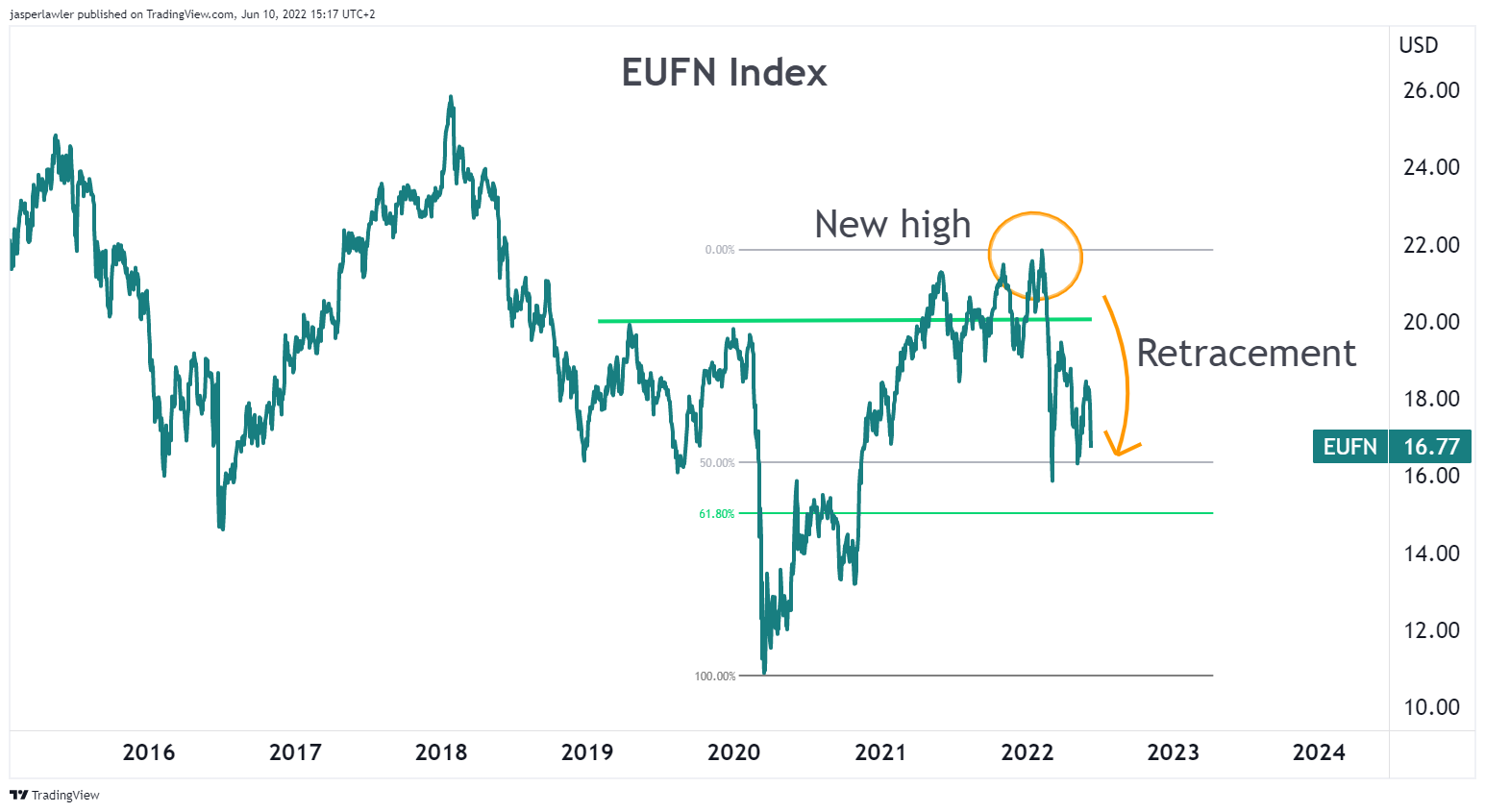The European banking sector has retraced around 50% of the solid rally off the lows printed during the unfolding of the pandemic in 2020. With valuations lowered and the ECB set to raise rates, is now the time to look toward European Banks?
The majority of these losses were driven by the uncertainty and risk-aversion which ballooned in the face of Russia invading Ukraine in late February. The vulnerability of the eurozone economy and the contagion risks stemming from the conflict prompted a large unwind of long positions in European banking stocks.
Added to this situation, the massive stimulus put in place by the ECB across the course of the pandemic was having a depressing impact on bank valuations as the US banking sector began to gain traction amidst Fed tightening expectations which took hold in Q1. This narrative gained greater traction into Q2 as other G10 central banks embarked upon (or moved further along) their own tightening path, creating a greater divergence between the European banking sector and that of the eurozone’s main trading partners.
There is a good case now for arguing that European banking stocks are set to rally across the remainder of the year. Less focus on the Russia-Ukraine conflict, a rising rates environment and better valuations all offer possible support.
ECB & net interest margins
A more hawkish tone from the ECB over recent weeks has raised the prospect of the tightening of policy this year. These prospects were confirmed this week at the June ECB meeting. With inflation surging ahead and the bank having abandoned its view that the spike would be transitory, the ECB announced an end to its asset purchase program and confirmed that a 25bps rate hike will be coming in July. Additionally, ECB chief Lagarde gave a further signal that a larger 50bps hike would likely be appropriate in September.
The impact of the first ECB tightening of credit conditions in over a decade is expected to be firmly positive for European banks. Hiking rates on loans and other credit instruments means higher net interesr margins as banks borrow in the long term and lend in the short. On the basis of rates, the profit outlook for many banks has now improved considerably.
The banks using floating-rate loans stand to the benefit most while more deposit-laden banks will see the benefit offset through higher payouts on deposits. Sector-wide, however, the net outcome is likely to propel the European banking sector to higher prices over the remainder of the year.
Downside Risks
However, there are risks to this outlook. With central banks around the world tightening monetary policy in the face of excessive inflation, recessionary fears are looming. The negative impact on businesses and consumers of paying higher rates, at a time when prices generally are elevated, is creating undue pressure. The risk is that ECB tightening, and subsequent tighter financial conditions generally, will lead to an uptick in credit defaults across the consumer and business spectrum. The ECB is aware of these risks, which potentially puts a ceiling on how far policymakers will go with rate hikes.
Vulnerable Eurozone Economy
The impact of two years of a pandemic-disrupted economy has led to crippling supply chain issues in the eurozone which have been exacerbated by Brexit-related difficulties as well as the fresh disruption caused by the violence in Ukraine. With these factors ongoing, consumers and businesses might be poorly placed to deal with a sudden tightening of financial conditions. With central banks hiking rates aggressively in the face of rampant inflation, rate path projections for the ECB now peg around 150bps worth of hikes by year-end.
Impact of Tighter Financial Conditions
This will translate into materially higher costs for consumers and businesses and, if a significant increase in defaults is noted, banking stocks might not feel the true benefit of charging higher rates.
European banks had only just started scaling back loan loss provisions on the back of the pandemic though are now likely to start rebuilding these reserves as rates rise, creating clear two-way risks should these buffers need to be utilised.
EUFN Technical Outlook
Finally, then, let’s take a look at the technical picture. One great way to track the movements in the European banking sector is to follow the MSCI Europe Financial Sector Fund (EUFN) which indexes the performance of Europe’s largest financial firms.
EUFN – Weekly Chart

Source: FlowBank / TradingView
The correction lower from the 2022 highs around the 22 level have seen the EUFN retracing 50% of the rally from 2020 lows. The 50% Fib level is holding as support for now, along with the retest of broken 2020 highs around 15. The objective for bulls now will be a break above the 19 level, opening the way for a move back up to 2022 highs. A break of yearly lows, however, might raise risks of a longer-term move lower.





